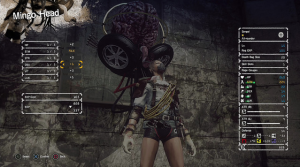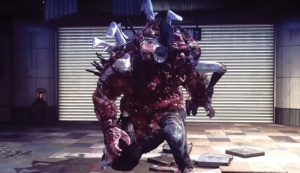Leave it to Grasshopper Manufacture to keep surprising us with strange games. The studio that brought us Killer 7, Killer is Dead and more, now has Let it Die: A F2P Rogue-like. Once again, the punk-inspired studio has a lot of surprises up their sleeves with something no one else has seen before. Unfortunately, playing the game makes you realize why that is.
Insert Quarter:
As with a Grasshopper Manufacture game, the story is certainly out there. You are playing the “arcade game” Let it Die, while being watched by Uncle Death. The game has you controlling human puppets to climb the Tower of Barbs to find a grand treasure.
The game oozes the style that we’ve seen from previous titles of Grasshopper. Expect to find a bunch of weird characters, crazy menu art, and of course the Punk soundtrack. Gameplay is a faster-paced take on the Souls experience. You have left and right hand attacks and stamina in the form of your heart rate. The game is not procedurally generated, but you can find random items and resources as you climb the tower. Entrances and exits tend to change on some maps, but the overall blueprint remains the same.
Weapons come in different types and all equipment has a durability factor. Weapons will do more damage and have added range, but you’ll have to rely on your fists when the time comes.
Every few floors will have an elevator that will let you return if you die, and is just one of the many forms of progression that Let it Die has.
Going Up:
As a rogue-like meant to be replayed, Let it Die has a lot of forms of persistence mechanics. Starting at the top layer, you can level up with each of the weapon types in the game. The killing blow on an enemy will grant experience with the chosen weapon. As you level up, you’ll be able to do more with that weapon type and unlock additional combo chains.
Your character itself can be leveled up with their core stats based on their class. Experience is tied to the character and there are different types of characters. This becomes very important with the death mechanic of the game, but more on that in a minute.
As you climb the tower, you’ll find blueprints that can unlock new items at the store, get decals to provide passive buffs and more.
The game’s persistence does a good job of giving you multiple areas to advance in beyond just progress. But like in all rogue-likes: You will die, and this is where Let it Die gets interesting.
Haters Gonna Hunt:
Beyond fighting the regular minions in the tower, the game throws some added challenge at you in the form of haters, and even yourself.
When a character dies and you choose not to revive them (more on that next), they will become a reanimated corpse or “hater.” To get the body back, you must defeat them.
Because stat increases are character-specific, you’re going to need to do this to keep your investment. If you don’t want to fight them, you can spend in-game currency to revive them back at the start.
Characters can also invade other games as haters themselves or be sent to you specifically as hunters. Defeating these characters will earn you a second resource that will be used for researching new gear at the shop. You can also unlock the ability to invade other player’s hubs for even more shenanigans.
Life and Death are major elements of Let it Die as with any rogue-like, but it’s also where the F2P elements come in.
Death Insurance:
Death in Let it Die can happen very quickly. If you die, you can use death metals to revive yourself on the spot. If you don’t do it, you can use money to revive them or go fight them as already mentioned.
Death Metals are the premium currency of the game and can be found through certain quests or by spending real money. As a frame of reference, it costs $4.99 for 10 death metals. Besides buying things directly, the game comes complete with a special premium subscription. Using special tickets, you can buy 30 days of enhanced service.
This will give you free decals every day, speeds up research timers, increase inventory space and allow you to use the elevator shortcuts for free.
Rogue-likes by their nature can be tough to get into, and while there isn’t a price wall here, the frustration is quite high.
Pay to Rogue:
Let it Die can be frustrating to play, and this goes to insane heights when we throw in the F2P mechanics. Combat is very sluggish due to slow uninterruptible attack animations. Your weapons and attacks are built on a three-hit combo chain; get hit and you will be stuck taking an additional two or three hits.
While the enemies are susceptible to this as well, there’s one big caveat. Fighting multiple enemies at once is impossible in the game. Because getting hit locks you in the hurt animation, multiple enemies can effectively stun lock you to death. Stronger attacks can literally kill you in one three-hit combo if it causes you to get stunned.
In a game like Dark Souls, your attacks are wide enough to hit multiple enemies who get too close; that’s not the case here. Unless you’re carrying the right weapon or have an explosive weapon, you just can’t fight them. And when you die, it’s going to cost you to get back to where you were.
The maps are very basic in their design, and it becomes repetitive very fast to keep running through them. Like other rogue-likes, items and their appearance are locked to specific areas in the tower. It doesn’t take long for you to see everything in a single section, and then it’s you just going through it again and again. If the maps were randomly generated or had some more variety, this wouldn’t be an issue.
To make matters worse, it’s hard to shake the fact that a rogue-like is using a lot of the F2P “fun pain” mechanics to get you to spend money.
Fun Pain Frustration:
The use of premium currency and arbitrary limitations were designed to get you to spend money. Having a 30-day subscription service for a singleplayer rogue-like just seems wrong to me. At its launch, Let it Die did not have its full store features unlocked, but supposedly things will be available soon.
Those kinds of purchases are there right from the get-go and are a major turn-off. The purchases also put that thought into your head that the game was designed to be intentionally frustrating and cumbersome to drive people to spend premium currency or real money.
It’s very easy to enter a negative feedback loop of losing money and time in the game. If you don’t spend (or can’t spend) the money to revive your best character, then you have to fight them. Meaning, you need to spend time grinding with a weaker character to level them up, but then you run the chance of them being killed.
To make things even worse, the game doesn’t save your state or position like in Soulsborne. If you don’t quit the game from the hub area (or get disconnected from the server), your character will be marked as dying when you return. After a few hours in, you unlock the option to buy an item that lets you suspend your save, but it costs in-game currency to use.
Let P2W Die:
Let it Die is very frustrating to play. I can see an amazing game trying to get out with the great style and mechanics of building a group of fighters. However, the more I play the game, the more elements become frustrating and locked or stalled behind the pay walls.
This comes close to being one of the best mechanics-wise games from Grasshopper Manufacture, but I don’t see the fun pain mechanics being worth it to spend money on. Rogue-likes by their nature walk the line between frustrating and fair design; they don’t need F2P elements to tip the scales.
If you want to see more of Let it Die, you can watch some footage I streamed:
If you enjoyed this post, please consider donating to the Game-Wisdom Patreon campaign. Your donations can help keep things going and allow me to produce more great content. Follow me on Twitter @GWBycer, and you can find daily video content on the Game-Wisdom YouTube channel.






